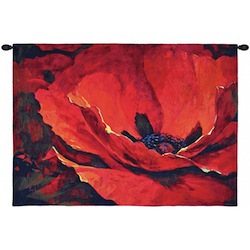When most of us think if modern art, tapestries are not what come to mind. Sadly, tapestry often has a reputation for being old and perhaps stodgy. Yet British artist Simon Bull was able to take his emotive eye and artistic expressions from canvass to tapestry in his piece called Desirée. This tapestry uses Bull’s original watercolor as a “cartoon”. It was woven in Belgium with his supervision. There is much about this piece that is beyond any verbal expression, but there are some things which are worth noting. Bull has described himself as a “chef for the retina” and this may hold the key to what can be said.
To begin, this is what Bull has to say about his work: “My work has a universal language. It seems to cross cultural barriers…I think it has something to do with the colors and the emotions I put into my work.” When one looks at this tapestry, they are immediately taken in by the aggressive use of reds, and the size of the poppy’s petals. There is a dark background with the reds and oranges bursting forth from the darkness. This represents transformation. For Bull, his personal transformation was religious, as he discovered that his artistic work was what God intended for him to do. As talented as he is, this was not obvious for him. For the viewer, the representation of metamorphosis may be different. There is the element of the importance of life shouting out from difficulties. There is the element of color coming out of blackness. And there is the element of rebirth.
In his own words: “Color is very important to be, and by combining color, tone and texture in different ways, it affects the senses profoundly…And so, like a composer of a symphony I blend different color notes and values to work on the back of the retina and send messages to the brain that are pleasurable, inspirational or in other ways provocative to the senses.”
Looking at “Desiree” what can we say is “provocative”? Color, for sure, but also it is the perspective of the poppy. Other than this piece, when have you ever experienced a poppy so large, so inflated? And what does this say about our own lives? One way to answer this, a way that is commensurate with Bull’s own words, is to notice that any life form is ultimately huge. The fact that any of us are alive is so statistically unlikely from a mathematical standpoint, that we must inflate our own sense of self.
Bull mentions texture, and this is likely why of all 30,000 paintings he has created, he chose this one to be made in to a tapestry. Why? What does the texture of fabric do for this image? It raises it upward. It feels both rough and soft, and it seems to move. Each of these changes from the canvas underscores and augments the provocative elements of this over-sized and over exaggerated poppy. Our lives are at the same time over-sized and exaggerated, both in meaningful and not so meaningful ways. If there is a taste in our mouths to be left, surely “Chef Bull” wants us to see the difference.
About the Author
Charlotte writes for Save On Tapestries and provides useful insight into the world of tapestries

